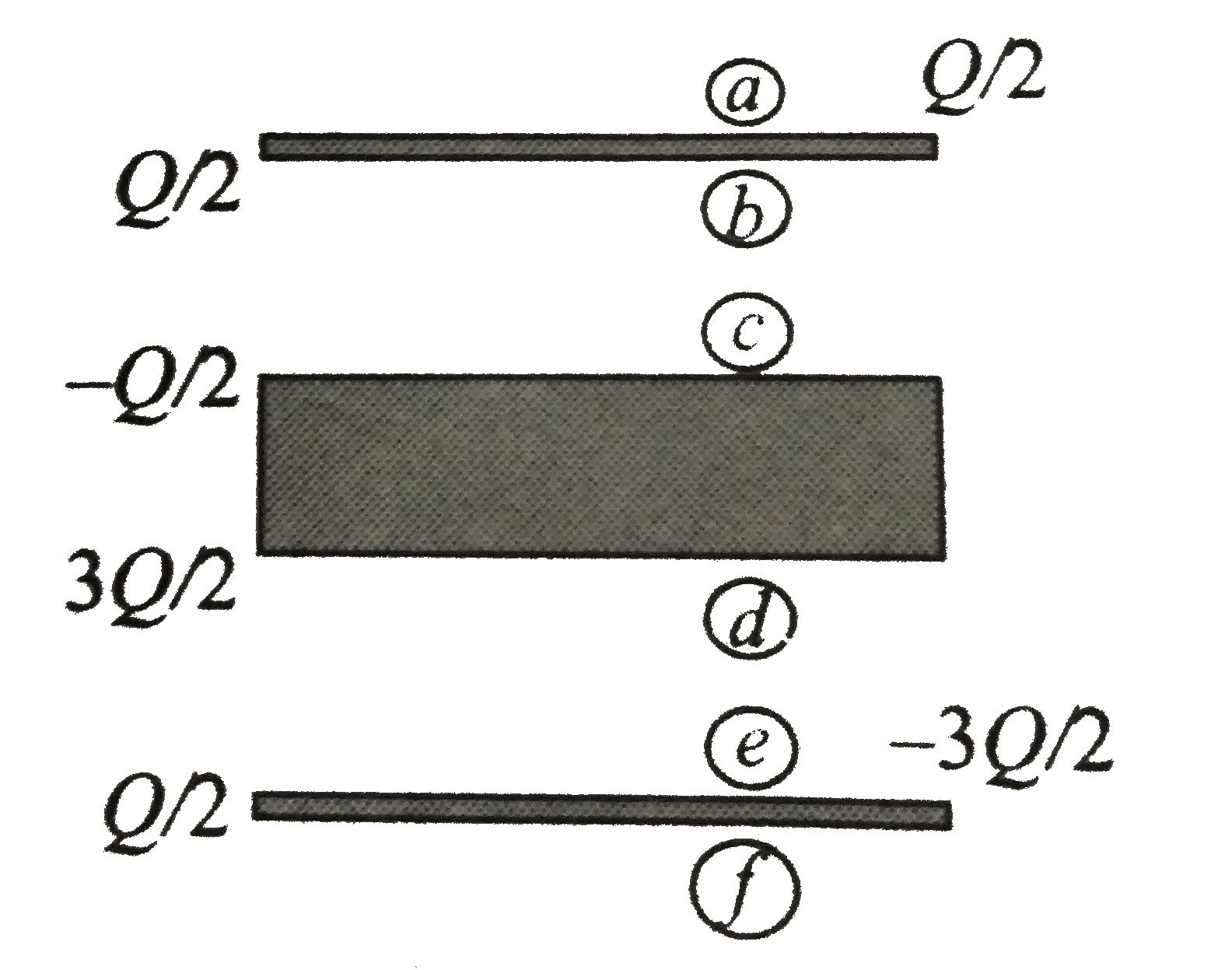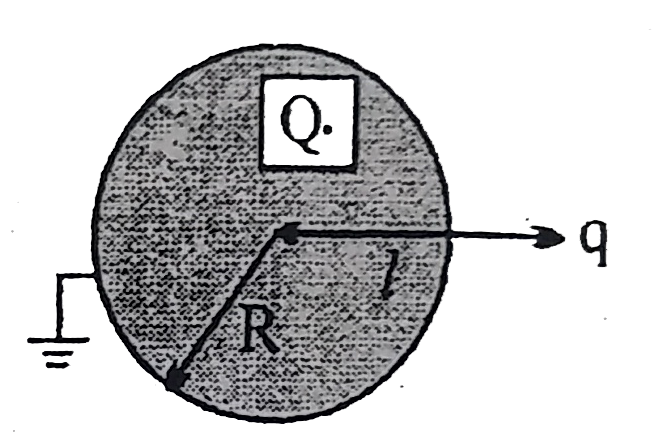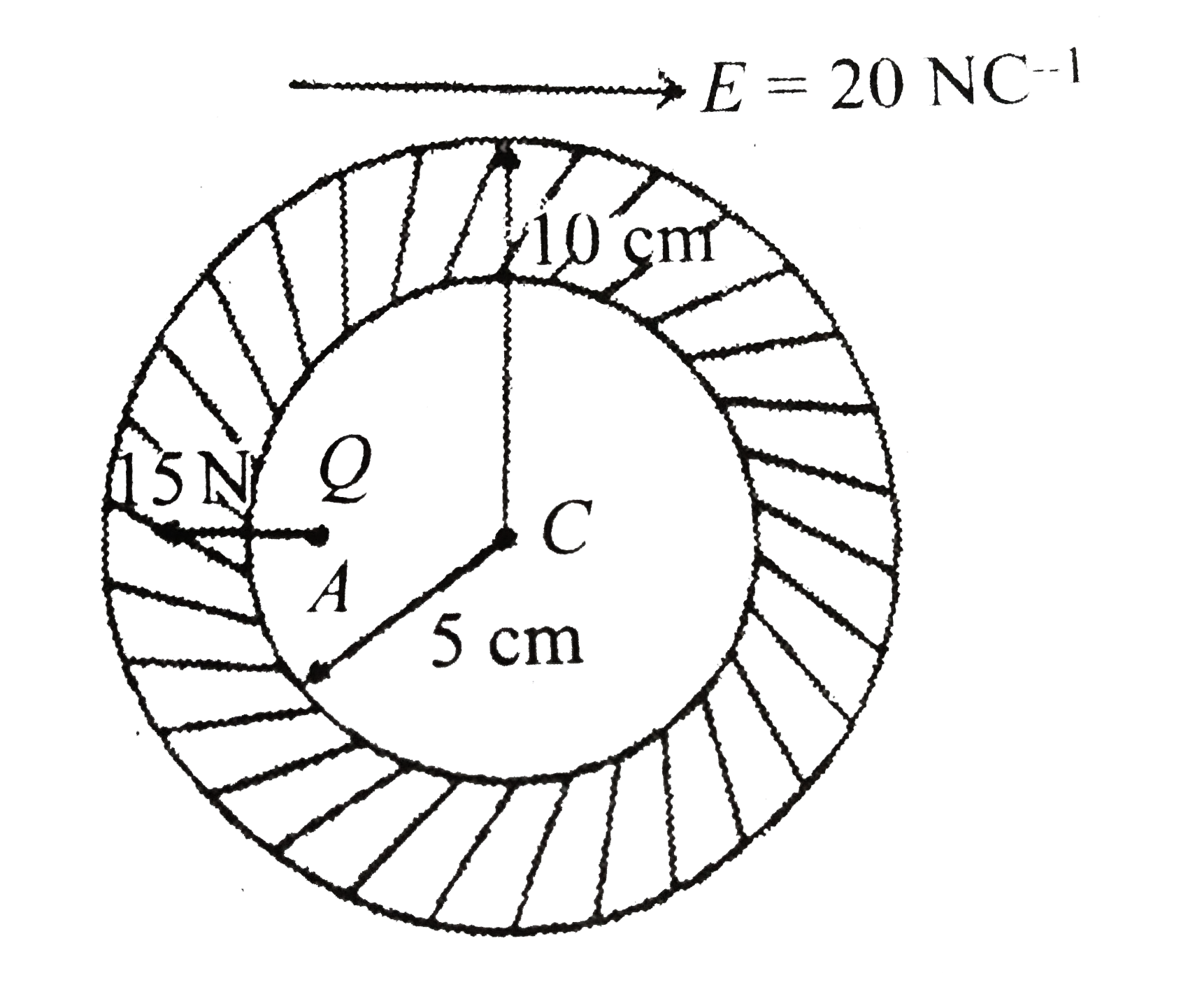S is a solid neutral conducting sphere. A point charge q of 1×10−6C is placed at point, C is the center of sphere, and AB is a tangent. BC = 3 m and B = 4m.

The electric potential of the conductor is 1.8 kV.
The electirc potential of the conductor is 2.25 kV.
The electric potential at B due to induced charges on the sphere is −0.45kV.
The electric potential at B due to induced charges on the sphere is 0.45kV.
The correct Answer is:A, C
a.,c.
Distance AC is given by AC=5m
Potential at due to charge q at A is given by
V=kqAC=9×109×1×10−65=1.8×103=1.8kV
Potential at B is given by
VB=(VB)due toq+(VB)induced
{(V)(B))i= Potential at B due to induced charge}
Thus 1.8×103=kqAB+(VB)i=2.25×103+(VB)i
(VB)i=−0.45kV
So (a) and (c) are correct

Topper's Solved these Questions
- MISCELLANEOUS VOLUME 3Book:CENGAGE PHYSICSChapter:MISCELLANEOUS VOLUME 3Exercise:Assertion and Reason Type
Explore 8 Videos
- MISCELLANEOUS VOLUME 3Book:CENGAGE PHYSICSChapter:MISCELLANEOUS VOLUME 3Exercise:Comprehension Type
Explore 94 Videos
- MISCELLANEOUS VOLUME 3Book:CENGAGE PHYSICSChapter:MISCELLANEOUS VOLUME 3Exercise:True and False
Explore 3 Videos
- MECHANICAL PROPERTIES OF SOLIDSBook:CENGAGE PHYSICSChapter:MECHANICAL PROPERTIES OF SOLIDSExercise:Question Bank
Explore 4 Videos
- MISCELLANEOUS VOLUME 5Book:CENGAGE PHYSICSChapter:MISCELLANEOUS VOLUME 5Exercise:Integer
Explore 12 Videos
Similar Questions
7S is a solid neutral conducting sphere. A point charge q of 1 × 10–6 C is placed at point A. C is the centre of sphere and AB is a tangent. BC = 3m and AB = 4m.
(1) The electric potential of the conductor is 1.8 kV
(2) The electric potential of the conductor is 2.25 kV
(3) The electric potential at B due to induced charges on the sphere is – 0.45 kV
(4) The electric potential at B due to induced charges on the sphere is 0.45 kV

View SolutionConsider a solid neutral conducting sphere S1 of radius r=3.0m. A point charge Q=+2μC s placed at point P such that AP=-4.0m (AP is tangent to the sphere). Charge Q' is induced on the surface of te conducting sphere S1. Consider another non conducting sphere (S2) of same radius r. Charge Q' is spread on the surfaec of S2 in exactly the same way as it is present on the surface of conducting sphere S1 [i.e., the distribution of charge on surface of S2 is exact replica of the induced surface charge on S1]. There is no other charge in vicinity of S2. Find the smallest potential (at a point) on the surface of sphere S2.

View Solution
Knowledge Check
Consider a neutral conducting sphere. A positive point charge is placed outside the sphere. The net charge on the sphere is then
Anegative and distributed uniformly over the surface of the sphereBnegative and appears only at the point on the sphere closest to the point chargeCnegative and distributed non-uniformly over the entire surface of the sphereDzeroConsider a neutral conducting sphere. A positive point charge is placed outside the sphere. The net charge on the sphere is then
ANegative and uniformly distributed over the surface of sphereBPositive and uniformly distributed over the surface of sphereCNegative and appears at a point the surface of sphere closest to point chargeDZeroAn electric charge of 8.85×10−13C is placed at the centre of a sphere of radius 1 m. The electric flux through the sphere is
A0.2NC−1m2B0.1NC−1m2C0.3NC−1m2D0.01NC−1m2
The centre of neutral conducting sphere of radius "R" is at distance 'd' from a point charge "Q" .The potential of the sphere is
View SolutionSurface charge density of a conducting sphere of a radius 10 cm is 8.85×10−8c/m2. Potential at the centre of the sphere is
View SolutionThere is a cubical cavity inside a conducting sphere of radius R. A positive point charge Q is placed at the centre of the cube and another positive charge q is placed at a distance 1(>R) from the centre of the sphere. The sphere is earthed

Net charge on the outer surface of conducting sphere is
View SolutionIn a conducting hollow sphere of inner and outer radii 5 cm and 10 cm, respectively, a point charge 1 C is placed at point A, that is 3 cm from the center C of the hollow sphere. An external uniform electric field to magnitude 20NC−1 is also applied. Net electric force on this charge is 15 N, away from the center of the sphere as shown. Find the magnitude of net force exerted on the charge placed at point A by the induced charges on the sphere

View SolutionFlux passing through the shaded surface of a sphere when a point charge q is placed at the center is (radius of the sphere is R)

View Solution
